| The Borough Council,
and Public Transport |
|
The
Borough Council, its staff and committees
The borough had 5 wards, each with
3 council members. There were also 5 aldermen, making 20
council members in all. The wards were as follows:
Town Ward, King’s
Hill Ward, Manor Ward, Wood Green Ward, and Mesty Croft
Ward.
The council’s affairs were
conducted by a number of committees:
| The Allotments
Committee |
| The Art Gallery
and Library Committee |
| The Baths
Committee |
| The Establishment
Committee |
| The Finance
Committee |
| The General
Purposes Committee |
| The Highways
Committee |
| The Markets and
Public Works Committee |
| The Housing
Committee |
| The Parks and
Cemeteries Committee |
| The Playing Fields
Committee |
| The Public Health
Committee |
| The Town Planning
Committee |
| |
|
Corporation officials
included:
| George
Frederick Thompson, Town Clerk,
Solicitor to the Corporation,
Electoral Registration Officer,
and Mayor’s Secretary |
| A. W.
Ewart, Borough Engineer and
Surveyor |
| J. S.
Hodges, Borough Treasurer |
| H. A.
H. Summers, Medical Officer of
Health |
| F. J.
Turner, Chief Public Health
Inspector |
| R. L.
Highfield, Housing Manager |
| A. J.
Crowe, Borough Librarian |
| S.
Dixon, Baths Superintendent |
| A. E.
Rhodes, Parks and Cemeteries
Superintendent |
|
The town was policed by the
Wednesbury Police Division of the Staffordshire County
Constabulary, which included Darlaston and Tipton. The
police station in Holyhead Road was next to the Court
House, where the Borough Magistrates sat every Friday.
The town had over 30 acres of
allotments, under the control of the Parks Department.
There were also several privately owned allotment sites. |
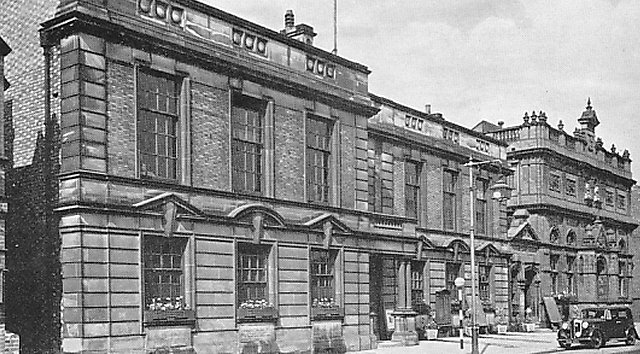
The Town Hall and Art Gallery.
|
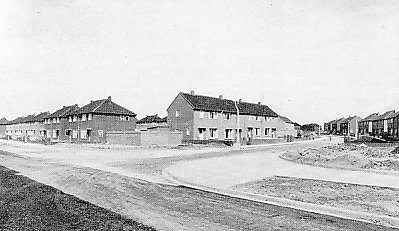
The Woods Estate. |
By the late 1950s the council had built nearly 5,000
houses and had plans for over 1,000 more. Since 1945
around 1,800 council houses and old people's bungalows
had been built.
The council also lent money under the terms of the
Small Dwellings Acquisition Acts to anyone wishing to
build, or purchase houses in the borough. |
| The pre Second World War council housing estates
were at: Churchfields, Crankhall
Lane, Dangerfield Lane, Fallings Heath, Manor Farm,
Mesty Croft, Moxley, Myvod Road and Park Lane, and Wood
Green.
The post war estates were at:
Crew Road, Dangerfield Lane
(Lodge Holes), Dingley Road, Friar Park, the Golf
Course, Mesty Croft, Millfields, and Park Lane and Old
Park Road. |
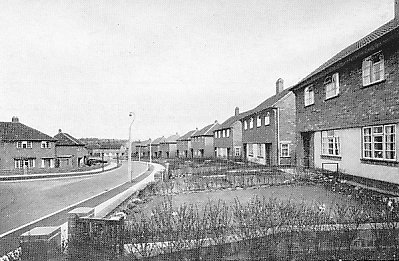
Millfields Estate. |
| Public Transport
Public transport was well catered for thanks to train
services between Wolverhampton and Birmingham, and
Walsall to Dudley. The London Midland Region station
linked the town directly with Walsall to the north, and
stations from Dudley
Port, to Worcester in the south. The Western Region
linked the town to Wolverhampton, Shrewsbury, and
Birkenhead in the north, and Birmingham in the south.
|
|
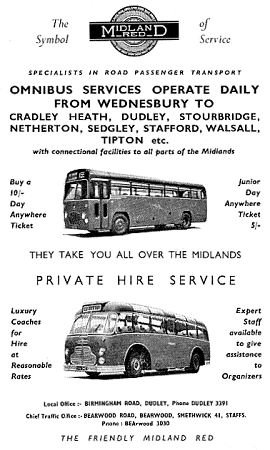
An advert from 1957. |
There were also frequent bus
services, operated by Birmingham, Walsall, West
Bromwich, and Wolverhampton corporations, and the
Midland Red. Popular bus routes included:
Routes 37 and 38. A circular route
from Walsall to Wednesbury, Darlaston, and back to
Walsall.
Routes 265 and 865. Stafford to
Dudley via Cannock, Walsall, Wednesbury, and Tipton.
Routes 10 and 11. Starting at
Ridding Lane, and travelling to West Bromwich via Mesty
Croft, Crankhall Lane, and Friar Park.
Route 31. Starting at Ridding Lane,
and travelling to West Bromwich via Hydes Road, and
Moorlands Estate.
Route 75. Starting at the White
Horse in Bridge Street, and travelling to West Bromwich,
and Birmingham.
Route 90. Travelling from West
Bromwich to Wolverhampton, via Wednesbury and Bilston.
Midland Red buses ran from the High
Bullen to Bilston, Dudley, Cradley Heath, Brierley Hill,
Sedgley, Stourbridge, Walsall, and James Bridge. |
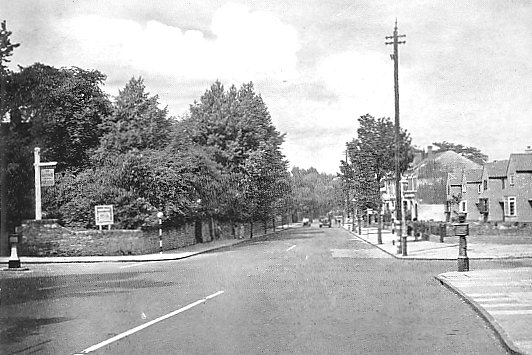
Wood Green.
 |
|
 |
Return to
the contents |
|
Proceed to Things
To See And Do |
|